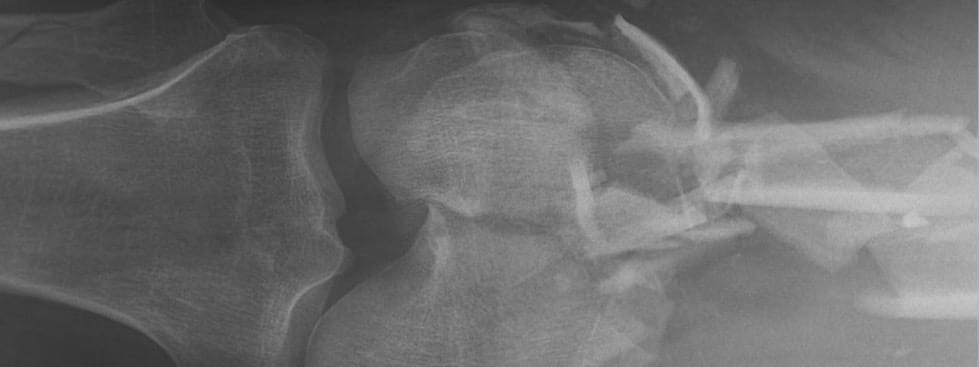Microwave Meltdown
aka Trauma Tribulation 011
An ambulance crew have radioed through to the emergency department. They are en route with a patient who has sustained a ‘microwave injury’…
Questions
Q1. What are the 3 main mechanisms of ‘microwave injury’?
Answer and interpretation
The most common source of microwaves in day-to-day life is the microwave oven. Injury may result from:
- direct thermal injury due to dielectric heating
- indirect thermal injury due to super-heating of fluids
- mechanical trauma – e.g. fragments of of an exploding superheated foodstuff or dropping a microwave oven on your toe!
Another potential hazard is exposure to toxic gases. This can result from the use of inappropriate food containers. For example, polymer fume fever can result from overheating and melting of teflon aka polytetrafluoroethylene (PFTE).
Q2. What is dielectric heating and what is the most important feature of the injuries it causes?
Answer and interpretation
In ‘simple physician-ly’ terms, this is how dielectric heating works:
- The microwave energy is absorbed by polar molecules. These molecules rotate and collide as a result. Thus the electromagnetic energy is converted into kinetic energy and generates heat.
- Polar liquids like water heat up more quickly in the microwave than either polar solids (e.g. ice) or less polar liquids such as oils.
Despite their safety mechanisms, microwave ovens are not fool-proof. There are reports of people managing to sustain direct thermal injury due to dielectric heating. Occasionally people somehow manage to burn their hands in a microwave oven… or, horrifically, a small infant…
Clinically, it is important to realise that:
Injuries sustained by dielectric heating resemble electrical burns in that the degree of internal thermal injury, and resulting necrosis, may be under-estimated due to the lack of external signs of injury.
Q3. What is super-heating and how might it lead to injury?
Answer and interpretation
Super-heating occurs when a liquid is heated to beyond its boiling point.
This can occur in undisturbed liquids in a smooth container that are free of nucleation sites as the formation of bubbles in the boiling process is suppressed by surface tension. Superheating is not limited to ‘pure’ fluids — it also occur in ‘impure’ fluids, like a cup of coffee, infant milk formula, or even an egg. When a superheated liquid is disturbed, rapid boiling may occur, and the result may be a violent explosion…
Microwave-heated food or drink items are also prone to causing internal thermal injuries following premature ingestion. This can occur because the food or drink may seem cool externally yet be internally superheated.
Most microwave manufacturers advise letting food stand for 2 minutes to allow adequate diffusion of heat — the more viscous the fluid, the longer the time required.
Standing time is particularly important with items that have fluid centres and a solid outer shell — examples include eggs, jelly-filled donuts and bottles of infant formula.
References
- Corridan P, Hsuan J, Price NJ, McDonnell PJ. Exploding microwaved eggs. BMJ.1992 Apr 18;304(6833):1053. PMID: 1586796; PMCID: PMC1881734.
- Goyal S, Choong YF, Aclimandos WA, Coakes RL. Penetrating ocular trauma from an exploding microwaved egg. BMJ. 2004 May 1;328(7447):1075. PMID: 15117801; PMCID: PMC403890.
- Offer GJ, Nanan D, Marshall JN. Thermal injury to the upper aerodigestive tract after microwave heating of food. J Accid Emerg Med. 1995 Sep;12(3):216-7. PMID: 8581254; PMCID: PMC1342487.
- Wikipedia, Microwave burn.
- Zanen AL, Rietveld AP. Inhalation trauma due to overheating in a microwave oven. Thorax. 1993 Mar;48(3):300-2. PMID: 8497834; PMCID: PMC464383.

CLINICAL CASES
Trauma Tribulation
Chris is an Intensivist and ECMO specialist at The Alfred ICU, where he is Deputy Director (Education). He is a Clinical Adjunct Associate Professor at Monash University, the Lead for the Clinician Educator Incubator programme, and a CICM First Part Examiner.
He is an internationally recognised Clinician Educator with a passion for helping clinicians learn and for improving the clinical performance of individuals and collectives. He was one of the founders of the FOAM movement (Free Open-Access Medical education) has been recognised for his contributions to education with awards from ANZICS, ANZAHPE, and ACEM.
His one great achievement is being the father of three amazing children.
On Bluesky, he is @precordialthump.bsky.social and on the site that Elon has screwed up, he is @precordialthump.
| INTENSIVE | RAGE | Resuscitology | SMACC
